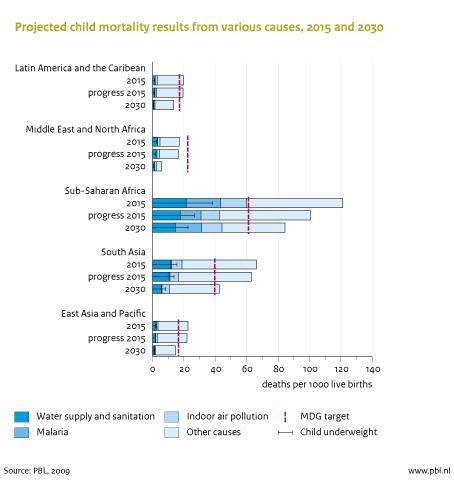Global Monitoring Report 2011: Improving the Odds of Achieving the MDGs
Based on their recent studies on the relation between environment and human development, the PBL has contributed to the World Bank’s Global Monitoring Report 2011: Improving the Odds of Achieving the MDGs. The outcomes of several reports resulted in a comprehensive contribution regarding the Millennium Development Goals (MDGs), which is given below. The main conclusion is that accelerated progress in access to food, clean drinking water, basic sanitation, and the use of modern energy sources are key to achieve the MDGtarget of reducing the mortality rate among children under the age of five, by two thirds.
Improving children’s health through sustainable access to food, water and energy
Sustainable access to food,water and energy may decrease child mortality, significantly. Especially in Sub-Saharan Africa, one-third of the child mortality gap with the MDGtarget for 2015 could be closed by reaching the MDGs on food, water and energy. This is the conclusion of the PBL in their contribution to the World Bank’s Global Monitoring Report 2011: Improving the Odds of Achieving the MDGs.
Estimates with the GISMO model
Of the estimated 10.5 million annual child deaths, the vast majority is caused by preventable and treatable diseases and certain conditions, including low dietary energy consumption (underweight), unsafe drinking water, lack of basic sanitation (diarrhoea), and indoor air pollution related to solid fuel use for cooking and heating (pneumonia). Based on socio-economic and environmental trends, the population that lacks adequate access to food, water and energy, and the resulting effects on child mortality has been estimated, using the GISMO model. Except for in the Middle Eastand North Africa, by 2015, progress will not be enough to reach the MDGtarget on child mortality, and Sub-Saharan Africa will not even come close to this target by 2030. Accelerated progress to achieve the MDGtargets on food, water and energy will significantly improve this situation (see Figure 1). This is especially the case in Sub-Saharan Africa, where approximately one-third of the child mortality gap with the MDGtarget for 2015 could be closed by achieving these other MDGs.
Pressure on scarce natural resources
Rising demand for food, water and modern energy will put pressure on scarce natural resources (e.g. fertile land used for both food and bio-energy, and the price of clean fuels such as kerosene for cooking). This will increase the price of especially food and energy, and thus hurt poor people in importing countries where governments are unable to guarantee affordable prices when global prices increase. Furthermore, the provision of food, water, and energy will become more difficult when natural resources are not properly managed or become degraded due to global environmental change. For example, climate change induces changes in precipitation and temperature patterns, potentially increasing the likelihood of short-term crop failure and long-term production decline, as well as water quality deterioration. The most vulnerable are poor and food-insecure countries at lower latitudes (especially in seasonally dry and tropical regions) that largely depend on rain-fed farming. Many of the pressures are slow moving and cannot easily be stopped because of major inertia, including the pressures of fertility transition and greenhouse gas accumulation. They become apparent only in the long term, after 2015 or even 2030, and will trap people in their poverty and reverse progress.
Accelerated progress in the other MDGs is crucial
Therefore, to achieve the MDG target on child mortality, accelerated progress in the other MDGs is key – particularly the MDGs on access to food, clean drinking water, basic sanitation, and the use of modern energy sources. Furthermore, policies that address increased access to food, water and energy should take global scarcities and global environmental changes into account. This may help to achieve the MDGs, as well as make those achievements more sustainable.

More information (PBL-reports)
- Towards a Global Integrated Sustainability Model: GISMO 1.0 status report
- Beyond 2015: Long-term development and the Millennium Development Goals
- Growing within Limits. A Report to the Global Assembly 2009 of the Club of Rome
- Scarcities in a sea of plenty: Global Resource Scarcities and Policies in the European Union and the Netherlands
- GISMO Model
Authors
Specifications
- Publication title
- Global Monitoring Report 2011: Improving the Odds of Achieving the MDGs
- Publication date
- 26 April 2011
- Publication type
- Publication
- Publication language
- English
- Product number
- 92579